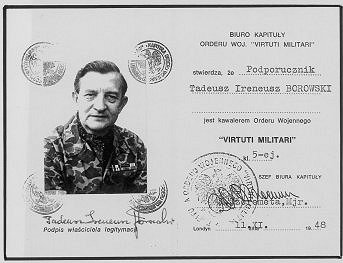IREK FROM THE UNDERGROUND
By: Terese Pencak Schwartz

“Irek” was his code name. But most people knew him as Tadeusz Borowski. Only other Polish resistance fighters knew him by his pseudonym, “Irek”. As 2nd Lieutenant in the Polish Home Army, (Armia Krajowa), “Irek” was responsible for men with names like: “Szczur”, “Ludwik”, “Jurek”, and “Chawcki”. He took his orders from “Waligora”, a.k.a. Major Jan Tarnowski, commander of “Wola” Region in Warsaw.
Wearing either stolen German uniforms or just plain street clothes, these homemade soldiers were the Polish Underground — the resistance fighters of Nazi-occupied Poland. Fathers, grandfathers and young boys fought side by side with only red and white armbands for identification. They came together to defend, as best as they could, their beloved homeland. They fought with Polish pistols and German “shmyzers”, automatic sub-machine guns, which they either stole or bought from the Nazis. They concealed their precious cache in cemeteries and hospital grounds.
The city sewers became their staging area, their Headquarters and their passage ways. The younger ones — teenagers worked as liaisons, running through the sewers smuggling supplies and passing cryptic messages and orders.
“One night,” says Borowski, “we got the order that our armbands must be switched before dawn from our left arms to our right arms.” The Germans had infiltrated their ranks. “In the morning we were instructed to shoot anyone wearing an armband on their left arm.”
Through the wet stinking sewers they moved like rats in sewage that was sometimes chest high. “We would have to dismantle our weapons,” says Borowski, “and carry them along with our ammunition over our heads so they would not get wet.”
In one almost comic military operation, Borowski, who speaks perfect German, dressed himself in a stolen Tirolean mountaineer’s outfit — complete with a feathered hat. With the help of three of his men, who followed discreetly in a “borrowed” German automobile, Borowski befriended three Nazi police officers. The charlatan then coyly maneuvered the German officers into a quiet cull-de-sac where his three partners were waiting.
By day Borowski worked within the walls of the Warsaw Ghetto as an engineer at the Tyton Fabryka at Dzeilna 62. Taking advantage of his freedom to pass through the well-guarded gates without suspicion, Borowski smuggled weapons, ammunition and forged documents inside for the Jewish Underground. He also worked with the Jewish Underground secretly preparing selected Jewish men and boys for combat.
“Zegota” was the cryptic code that became the word for the Polish Council of Assistance to the Jews (Rada Pomocy Zdom) established with the approval of several Polish organizations on December 4, 1942. Headquartered in Warsaw, Zegota had branches in several cities and major villages throughout Poland. Zegota aided the Jews both inside and outside the ghettos by providing forged documents, food, lodging, medicine and financial support.
Tadeusz Ireneusz Borowski, Sr. was only one of several thousand Polish resistance fighters. With his ability to speak four languages fluently and his cunning talent for the art of war, he became a hero many times over. For his active participation in the Warsaw Ghetto uprising, and for his part in smuggling arms into the Ghetto, Borowski was awarded the Cross of Valour and The Cross of Merit with Sword. In 1948, he received the highest medal of honor to be bestowed on a Polish soldier, the Virtuti Militari Class V. Even 40 years later, Borowski flew to Warsaw where he was, again decorated with medals, including one inscribed, “To the Heroes of the Warsaw Ghetto 1940 – 1943.”
Not all of Borowski’s heroism was of a military type. There is a Jewish woman alive today in a coastal town in California because she was rescued by “Irek” when she was five years old. He placed the young Jewish girl with a Polish Catholic family who also had a young daughter. Each month he sent money to the family for her support. The two girls lived and played together as sisters until the Catholic girl, Basha, was killed during a Soviet air attack in June 1942. Basha’s parents gave the Jewish girl their daughter’s identity. This new name and paperwork enabled the new “Basha” to elude the Nazis.
Pursued by the Soviet Political Police, (NKVD), even after the war, Borowski left Poland in 1950. He emigrated to the United States with his wife, Helena, who had worked as a double agent in a German submarine base for the Polish Intelligence. They raised three children while Mr. Borowski worked as a design engineer for Lockheed. Today, Borowski, now a widower, lives in Southern California with his dog, “Lady”. A true Polish patriot even in his 80’s, Borowski is still active in Scouting and the Polish community. His home is a museum of books, photos, medals, and Polish folk art. He is unabashedly proud of his wartime accomplishments but his feelings of pride are clouded by the neo-criticism of occupied Poland and the Polish people during the Holocaust. “I risked my life to save lives,” says Borowski, in a proper Eastern European accent. “I’m not looking for glory. I just want people to know the truth [about] what happened.”




